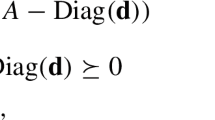Abstract
A (0, 1) matrix is linear if it does not contain a 2×2 submatrix of all ones. In this paper we give polynomial algorithms to test whether a linear matrix is balanced or perfect. The algorithms are based on decomposition results previously obtained by the authors.
Similar content being viewed by others
References
C. Berge, “Farbung von graphen, deren samtliche bzw. deren ungerade kreise star sind (Zusammenfassung),” Will. Z. Martin Luther University, Halle Wittenberg Math. Natur. Reihe (1961) 114.
C. Berge, “Balanced matrices”,Mathematical Programming 2 (1972) 19–31.
V. Chvátal, “On certain polytopes associated with graphs,”Journal of Combinatorial Theory, Series B 18 (1975) 138–154.
M. Conforti, “Diamond free perfect graphs and star cutsets,” in: B. Simeone, ed.,Lecture Notes in Mathematics (Springer, Berlin, 1990).
M. Conforti and M.R. Rao, “Articulation sets in linear perfect matrices and hypergraphs II: The wheel theorem and clique articulations,” (1986), to appear in:Discrete Mathematics.
M. Conforti and M.R. Rao, “Structural properties and recognition of restricted and strongly unimodular matrices,”Mathematical Programming 38 (1987) 17–27.
M. Conforti and M.R. Rao, “Odd cycles and matrices with integrality properties,”Mathematical Programming (Series B) 45 (1989) 279–294.
M. Conforti and M.R. Rao, “Properties of balanced and perfect matrices,”Mathematical Programming 55 (1992a) 35–47.
M. Conforti and M.R. Rao, “Structural properties and decomposition of linear balanced matrices,”Mathematical Programming 55 (1992b) 129–168.
M. Conforti and M.R. Rao, “Articulation sets in linear perfect matrices and hypergraphs I: Forbidden configurations and star cutsets,”Discrete Mathematics 104 (1992c) 23–47.
J. Fonlupt and A. Zemirline, “A polynomial recognition algorithm forK 4 —e free perfect graphs,” Research Report, University of Grenoble (Grenoble, 1987).
M. Golumbic,Algorithmic Graph Theory and Perfect Graphs (Wiley, New York, 1980).
G.L. Nemhauser and L. Wolsey,Integer and Combinatorial Programming (Wiley, New York, 1988).
M. Padberg, “Perfect zero–one matrices,”Mathematical Programming 6 (1974) 180–196.
K.R. Parthasarathy and G. Ravindra, “The validity of the strong perfect-graph conjecture for (K 4 −e) free graphs,”Journal of Combinatorial Theory, Series B 26 (1979) 17–27.
A. Tucker, “Coloring perfect (K 4 −e) free graphs,” Technical Report, SUNY (Stony Brook, 1985).
S. Whitesides, “An algorithm for finding clique cut-sets,”Information Processing Letters 12 (1981) 31–32.
M. Yannakakis, “On a class of totally unimodular matrices,”Mathematics of Operations Research 10 (1985) 280–304.
Author information
Authors and Affiliations
Additional information
Partial support under NSF Grants DMS 8606188, DDM8800281 and DDM9001705.
Rights and permissions
About this article
Cite this article
Conforti, M., Rao, M.R. Testing balancedness and perfection of linear matrices. Mathematical Programming 61, 1–18 (1993). https://doi.org/10.1007/BF01582135
Received:
Revised:
Issue Date:
DOI: https://doi.org/10.1007/BF01582135




